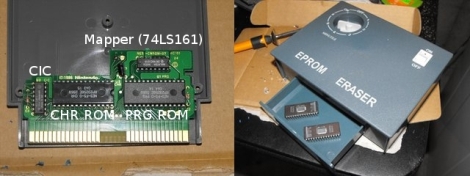Sometimes emulators just don’t cut it when you want to play a vintage game. Like it or not, some people enjoy the nostalgia of playing old games on the actual hardware for which it was designed.
[Callan] wrote in to share a method he has been using to make some of his own NES game cartridges from ROM dumps in order to play them on an honest to goodness NES console.
He starts out with a 190 in 1 game cartridge, where he found a neat Famicom game never released in the US. He decided he would patch the ROM he found on the multicart in order to have an English menu, and then create his very own cartridge from the image. He discusses how to identify which EPROM chips you will need in order to construct your cartridge, as well as some helpful ways of finding a donor cart that has a similar enough board to house your components.
[Callan] also provides a quick walkthrough of erasing and burning your new EPROM chips, before discussing some post-soldering troubleshooting steps you might need to take before your game will work properly.
While we can’t comment on the legality of these game clones, we still think it’s pretty awesome.
Be sure to check out his site for a far more in-depth discussion of the process if this is something that interests you.













